Category: Small town

In Praise of Ham and Bean Soup
I’ve never understood why a smoky, delicious ham and bean soup is so hard to find. Heck, just a lackluster, ho-hum ham and bean soup is often hard to find.
I always figured no one knows more about ham and bean soup than Iowa farm cooks, especially when those who grew up on a hog farm like I did. Pork galore in all its forms was a staple on our family’s dinner table for generations. Plus, soup night was always Sunday night at our farm—and it still is. What a treat when ham and bean soup is on the menu!
With its rich broth and smoky undertones, there’s nothing like a hearty ham and bean soup to chase away the winter chill (or bitter cold, depending on what Mother Nature throws at us.) As I’ve refined my own recipe through the years, I’ve come to three conclusions:
1. You MUST have a thick, smoked ham hock (also known as a ham shank) to make the magic. No cubes of cured ham are going to cut it, if you want maximum flavor. This is a heavy-duty, low-and-slow kind of job for a tough, smoky ham shank.
2. We’re blessed to have many great meat lockers in Iowa, a reflection of our thriving livestock industry, where I can get fabulous smoked ham hocks. One of my favorite suppliers? Lewright Meats in Eagle Grove, which has been serving northern Iowa since 1936.
3. Adding diced potatoes is a good thing for ham and bean soup. I like to add oomph to my cooking, and how can you go wrong with extra veggies? Adding potatoes might be a bit non-traditional for ham and bean soup, but that’s how I roll.
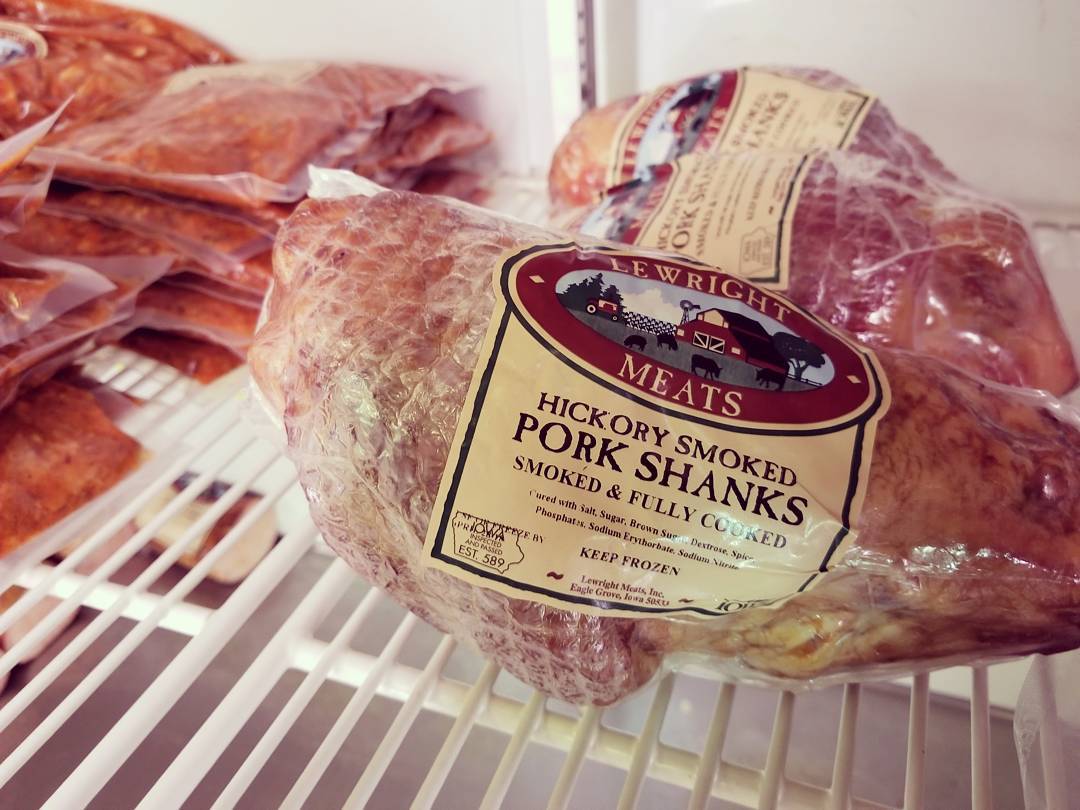
This smoked ham hock from Lewright Meats in Eagle Grove is the key to a great ham and bean soup.
The thing about ham and bean soup is that it can be a palette you fine-tune to your own tastes. Don’t like garlic? Leave it out. Want more onions in the mix? Add another one. (As my dear neighbor and farm cook extraordinaire Alice Ann Dial taught me, onions are a cheap way to add lots of flavor.)
The story behind Congress and Bean Soup
“Thunderation,” roared Speaker of the House Joe Cannon of Illinois. “I had my mouth set for bean soup! From now on, hot or cold, rain, snow, or shine, I want it on the menu every day.”
Obviously, ham and bean soup isn’t just a farm favorite. Turns out it has a rich history in the kitchens of Washington, D.C., too.
While ham and bean soup was a common item on the U.S. House of Representatives’ menu before the turn of the 20th century, it became a permanent fixture in the institution when Speaker Joe Cannon of Illinois discovered that his favorite meal had not been prepared by the kitchen staff on a hot, summer day in 1904.
Cannon, who was the namesake of the Cannon House Office Building, served in the U.S. House for 46 years. Dismayed by that egregious menu omission in 1904, the Speaker directed that bean soup be served in the House every day, regardless of the weather.
More than a century after Speaker Cannon’s decree, bean soup remains on the menu in the House Restaurant, making it one of the more longstanding and famous traditions in the House.
Members of the U.S. House aren’t the only fans of ham and bean soup. It’s also on the menu in the Senate’s restaurant every day. There are several stories about the origin of that mandate, but none has been corroborated.
According to one story, the Senate’s bean soup tradition began early in the 20th-century at the request of Senator Fred Dubois of Idaho. Another story attributes the request to Senator Knute Nelson of Minnesota, who expressed his fondness for the soup in 1903.
The recipe attributed to Dubois includes mashed potatoes and makes a 5-gallon batch. The recipe served in the Senate today does not include mashed potatoes, but does include a braised onion. Click here to check out both Senate recipes.
No matter how you like your ham and bean soup, here’s my take on this American classic. Enjoy, and let me know what you think.
Darcy’s Hearty Ham and Bean Soup
1 smoked ham hock (also called a smoked ham shank)—the meatier, the better
1 48-ounce jar great northern beans (I don’t drain and rinse the beans—I add it all)
3 stalks celery, diced
3 carrots, peeled and sliced
3 to 4 medium potatoes, diced (I prefer Yukon Golds)
1 large onion, chopped
1 tablespoon garlic, minced
1 teaspoon fresh-ground pepper
Water or chicken stock
Salt, to taste
Place ham hock in slow cooker. Add beans, celery, carrots, potatoes, onion, garlic and pepper. Cover with water or chicken stock until slow cooker is full. (If using water rather than chicken stock, I often add 2 or 3 teaspoons of Better Than Bouillon chicken soup base to add more flavor.)
Cook on low for 8 to 10 hours. (I often prepare the soup in the evening and let it cook overnight.) Remove ham hock, allow it to cool, and remove ham from the bone. Add ham back to the soup. Taste the soup to see if it needs salt. Add salt, if desired. (Some ham hocks add enough flavor to the broth that no salt is needed.)
• Note: homemade soup often develops more flavor if you let it sit in the refrigerator overnight and serve the soup the next day. This Hearty Ham and Bean Soup is so good, though, that I understand if you dig in right away!
P.S. Thanks for joining me. I’m glad you’re here.
Want more?
Thanks for stopping by. I invite you to read more of my blog posts if you value intriguing Iowa stories and history, along with Iowa food, agriculture updates, recipes and tips to make you a better communicator.
If you like what you see and want to be notified when I post new stories, be sure to click on the “subscribe to blog updates/newsletter” button at the top of this page, or click here. Feel free to share this with friends and colleagues who might be interested, too.
Also, if you or someone you know could use my writing services (I’m not only Iowa’s storyteller, but a professionally-trained journalist with 20 years of experience), let’s talk. I work with businesses and organizations within Iowa and across the country to unleash the power of great storytelling to define their brand and connect with their audience through clear, compelling blog posts, articles, news releases, feature stories, newsletter articles, social media, video scripts, and photography. Learn more at www.darcymaulsby.com, or e-mail me at yettergirl@yahoo.com.
If you’re hungry for more stories of Iowa history, check out my top-selling “Culinary History of Iowa: Sweet Corn, Pork Tenderloins, Maid-Rites and More” book from The History Press. Also take a look at my latest book, “Dallas County,” and my Calhoun County” book from Arcadia Publishing. Both are filled with vintage photos and compelling stories that showcase he history of small-town and rural Iowa. Order your signed copies today! Iowa postcards are available in my online store, too.
Let’s stay in touch. I’m at darcy@darcymaulsby.com, and yettergirl@yahoo.com.
Talk to you soon!
Darcy
@Copyright 2018 Darcy Maulsby & Co.
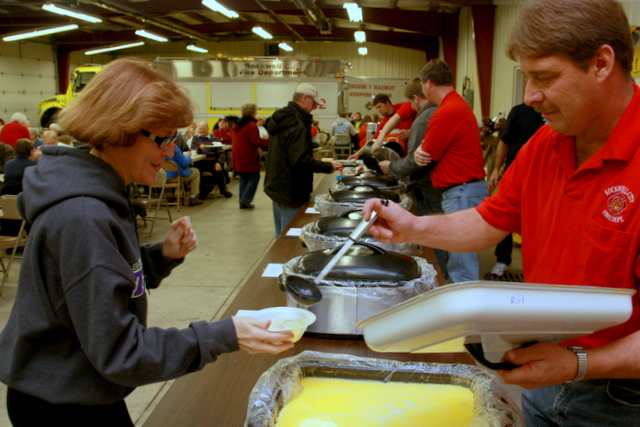
Mmm, Mmm Good: Soup’s on at the Rockwell City Fire Department
While soup is often considered little more than a prelude to something bigger, that’s not the case at the Rockwell City Fire Department. Throughout the winter, roasters filled with homemade chili, cheesy chicken noodle soup and other favorites make the fire station one of the hottest destinations in town.
“We typically serve 300 to 400 people at each supper,” said Duane Murley, a well-known farm broadcaster who has served on the Rockwell City Fire Department for 21 years. “Many times we have a line out the door.”
Murley and his fellow firefighter, Phil Hammen, co-chair the soup suppers, which are held the second Sunday of November, December, January and February from 4 p.m. to 6:30 p.m. at the fire station in Rockwell City. There’s no set fee to attend the soup suppers, which are supported by free-will donations.
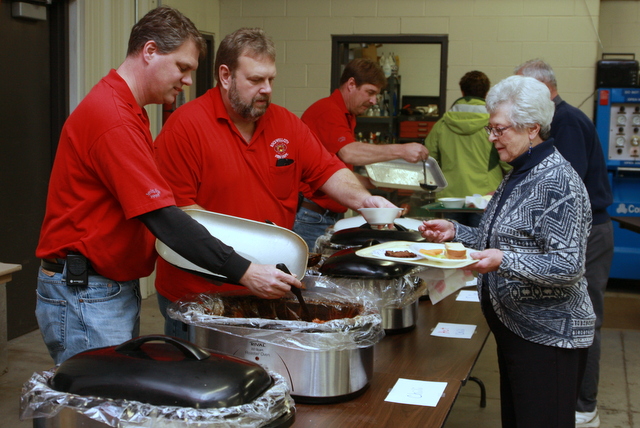
The volunteer firefighters serve two kinds of chili, cheesy chicken noodle soup, 8-Can Soup and more.
“This isn’t so much a money maker as it’s a way for the community to come together,” said Murley, who noted at the soup suppers have been held each winter for nearly seven years.
Many of the guests come from Rockwell City, Lake City, Manson and Twin Lakes. “I like to stop by and help support another local fire department,” said Josh Waller, who serves on the Manson Fire Department and the Calhoun County Farm Bureau board.
While each soup supper includes standard items such as potato soup and chili, the firefighters also mix things up with cheeseburger soup and other options. Each December, local supporters donate ingredients for the oyster stew, which is always a big hit. “They always have lots of good soup here and lots of variety,” said Toni Kerns of Rockwell City.
The firefighters often begin making their soups on Thursday or Friday before the Sunday soup supper. “The key to a good soup is to give it enough time to develop plenty of flavor,” said Phil Hammen, who co-chairs the soup suppers.
Perhaps the simplest—yet most talked-about—menu items are the famous lettuce sandwiches. These are just what they sound like—leaves of lettuce sandwiched between two slices of bread spread with mayonnaise or butter.
“These started as a joke,” said Murley, who recalled his mother-in-law’s stories of eating lettuce sandwiches during her school days at Jolley. “Now people look forward to them so much that we often use seven pounds or more of lettuce during our soup suppers.”
From the lettuce sandwiches to the homemade soups, the firefighters want guests to relax and reconnect with friends and family. “It’s not just about the food,” Murley said. “It’s about being part of the community.”
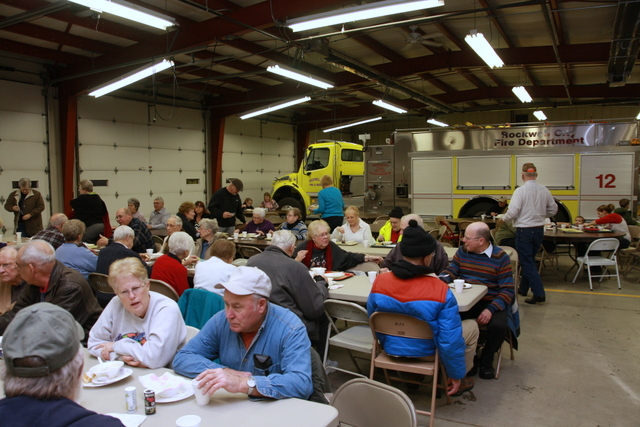
Cold Iowa winter nights don’t deter locals from enjoying the monthly soup suppers at the Rockwell City Fire Department.
8-Can Soup
People often ask if this flavorful soup really contains eight cans of ingredients. Yes it does, says Shane Voith, who has served as Rockwell City’s fire chief, who often multiplies this recipe by five to make this hearty soup for the soup supper.
1 can Hormel chili with beans
1 can Hormel chili, no beans
1 can sliced potatoes, undrained
1 can cut green beans, undrained
1 can whole-kernel corn, undrained
1 can mixed vegetables, undrained
1 can vegetable beef stew
1 can steak and potato soup
1 packet of powdered ranch dressing
Combine all ingredients in a large slow cooker, kettle or roaster. Cook on low all day, or for 2 to 3 hours on high to get the soup hot.
Sweet Chili
Jonathan Wetter, a Rockwell City volunteer firefighter, got this recipe from a friend. It’s reminiscent of both a sweet chili and calico beans.
Half a pound of bacon, cooked and diced
1 pound ground beef, browned
1 can lima beans, drained
1 can butter beans, drained
1 can kidney beans, undrained
1 can pork-and-beans, undrained
1 small onion, chopped
16-ounce can crushed pineapple
1 tablespoon mustard
4 tablespoons molasses
2 tablespoons vinegar
1 / 2 cup brown sugar
1 teaspoon Worcestershire sauce
1 / 2 cup ketchup
Combine all ingredients. Cook on low in a slow cooker or roaster for a few hours until hot.
Firehouse Chili
Duane Murley, co-chair of the fire department’s soup suppers, often makes three roasters of this chili, including one batch with hot peppers for a spicier chili.
7 pounds hamburger, browned
2 gallons Bush’s chili beans
2 gallons diced tomatoes
1 gallon tomato juice
Hot peppers, diced—optional
Cookies Flavor Enhancer, to taste
Chili powder, to taste
Combine all ingredients in a kettle, slow cooker or roaster. Cook on high for several hours or on low all day.
Potato Soup
Phil Hammen, co-chair the fire department’s soup suppers, specializes in this filling Potato Soup. This recipe makes enough to fill one roaster.
15 pounds potatoes, diced and boiled until tender
3 onions, diced
3 ham steaks, cubed
1 1 / 2 gallons 2% milk
2 sticks butter
Combine all ingredients in roaster. Cook until soup is heated through.
Cheesy Chicken Noodle Soup
This perennially popular soup is prepared by firefighter Kyle Welander of Rockwell City. When he cooks for the soup suppers, he boils eight whole chickens, removes the meat from the bones and saves the liquid to make homemade chicken broth.
1/4 cup butter, melted
1/4 cup flour
3 cups chicken broth
1 cup milk
2 cups Velveeta processed cheese, cubed
2 cups egg noodles, cooked
2 cups cooked, diced chicken
Melt butter in a large saucepan and add flour. Add chicken broth and milk. Cook, stirring occasionally on medium-high heat, until the mixture starts to bubble and thicken. Add cubed Velveeta cheese, and stir until melted. Pour mixture into larger pan or kettle. Add 2 cups of cooked egg noodles and 2 cups cooked, diced chicken. Cook on low. To fill a roaster, multiply this recipe by eight.
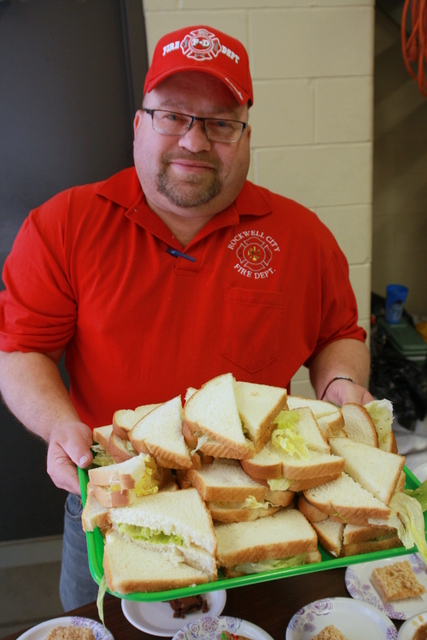
Calhoun County’s Famous Lettuce Sandwiches
Sliced bread
Mayonnaise or butter
Lettuce
Spread slices of bread with mayonnaise or butter. Top the bottom slice with a few leaves of lettuce. Add top slice of bread to complete the sandwich.
Lois Hensel’s Cake
Shelly Hammen of Rockwell City often makes desserts for the fire department’s soup suppers, including this incredible cake that was made famous by Lois Hensel, a long-time cake baker from Lake City. This recipe has been copied from a local cookbook.
2 packages Betty Crocker white cake mix, plus 1 1 / 2 cups from a third box of cake mix
7 / 8 cup egg whites
3 cups water
1 / 2 cup vegetable oil
1 1 / 2 teaspoons almond flavoring
1 / 2 teaspoon butter flavoring
Place cake mixes in mixer bowl. Add 2 cups of water and start mixing. Add egg whites, vegetable oil, almond flavoring, butter flavoring and remaining 1 cup of water. Continue mixing for 2-3 minutes until batter is smooth.
Line two sheet-cake pans (10.5 inches by 15.5 inches by 1 inch) with typing paper (paper may overlap). Pour half of the batter into the first pan. (This should weigh about 3.5 pounds or a bit more.) Place this pan on top oven rack. Bake 10 minutes at the recommended baking temperature on the cake mix box.
Stir the rest of the batter a bit with a spatula. Pour this batter into second cake pan. When first cake tests done (by a light touch of a finger) after about 20 minutes, remove cake from oven. Place second cake on top rack in oven. Bake until done.
Cool the first cake about 10 minutes, and run a knife around the four sides to loosen. Place a few layers of newspaper on both the cake top and on a bigger board. Holding securely, turn cake over onto the board, and peel liner paper off the cake. The brown on top of the cake will now adhere to the newspaper; peel off newspaper.
Place prepared board over cake, holding securely. Turn board and cake over, and place liner paper on cake. Place this in a plastic bag and freeze. It will be easy to trim the four sides with a serrated knife when cake is removed from the freezer.
Have icing ready. Stack four to five piece of 10.5-inch by 15-inch cardboard covered with tinfoil to hold each cake.
Lois Hensel’s Cake Icing
3 / 4 cup egg whites
4 pounds powdered sugar, divided
4 large “blobs” of Crisco shortening
1 teaspoon salt
1 / 2 cup water
1 teaspoon almond flavoring
1 / 2 teaspoon butter flavoring
1 / 2 teaspoon (or more) lemon flavoring
2 teaspoons clear vanilla
Place egg whites in mixer bowl. Add a pound of powdered sugar. Mix, and add shortening and salt. As you continue to mix, add water, remaining powdered sugar, almond flavoring, butter flavoring, lemon flavoring and clear vanilla. Don’t beat—just mix until smooth and until the right consistency is reached, scraping the sides of the bowl with a spatula. Add more powdered sugar, if needed.
This feature originally ran in Farm News.
P.S. Thanks for joining me. I’m glad you’re here.
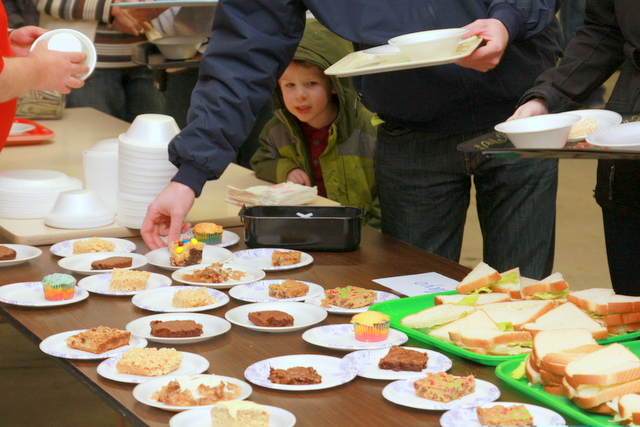
Everyone loves dessert at the soup supper.
Want more?
Thanks for stopping by. I invite you to read more of my blog posts if you value intriguing Iowa stories and history, along with Iowa food, agriculture updates, recipes and tips to make you a better communicator.
If you like what you see and want to be notified when I post new stories, be sure to click on the “subscribe to blog updates/newsletter” button at the top of this page, or click here. Feel free to share this with friends and colleagues who might be interested, too.
If you’re hungry for more stories of Iowa history, check out my top-selling “Culinary History of Iowa: Sweet Corn, Pork Tenderloins, Maid-Rites and More” book from The History Press. Also take a look at my latest book, “Dallas County,” and my Calhoun County” book from Arcadia Publishing. Both are filled with vintage photos and compelling stories that showcase he history of small-town and rural Iowa. Order your signed copies today! Iowa postcards are available in my online store, too.
Also, if you or someone you know could use my writing services (I’m not only Iowa’s storyteller, but a professionally-trained journalist with 20 years of experience), let’s talk. I work with businesses and organizations within Iowa and across the country to unleash the power of great storytelling to define their brand and connect with their audience through clear, compelling blog posts, articles, news releases, feature stories, newsletter articles, social media, video scripts, and photography. Learn more at www.darcymaulsby.com, or e-mail me at yettergirl@yahoo.com.
Let’s stay in touch. I’m at darcy@darcymaulsby.com, and yettergirl@yahoo.com.
Talk to you soon!
Darcy
@Copyright 2018 Darcy Maulsby & Co.
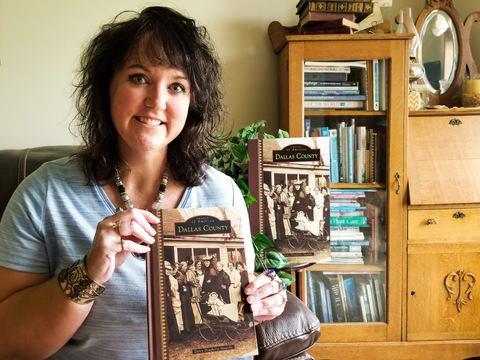
The Hotel Pattee and I are Hosting a Party—And You’re Invited!
What are you doing on Monday evening, Sept. 11? I would like to personally invite you to Perry to the historic Hotel Pattee at 7 p.m. for the debut of Dallas County, my latest non-fiction Iowa history book. It’s all here—drama, crime (Bonnie and Clyde), politics (Dallas County made President Harry Truman the original Comeback Kid), romance, tragedy, mystery, action, adventure, sports, food, agriculture, architecture, science, business, biography, comics and more—all told through more than 100 vintage photos and short stories in 10 chapters.
During this fun event at the hotel (click here for all the details!), I’ll take you on a time-traveling virtual tour of fun, surprising and sometimes shocking Dallas County history highlights. Stick around for the book signing after the program, and then stroll through the iconic Hotel Pattee to tour some of the guest rooms that will be open that evening. Every room in this grand boutique hotel features unique décor that tells the stories of Perry, Dallas County and Iowa history.
I’ve specifically asked that the luxurious Louis Armstrong Suite be open that evening. (In case you’re wondering about the Iowa connection, Louis Armstrong performed in Dallas County in 1954 at the legendary Lake Robbins Ballroom near Woodward and stayed at the Hotel Pattee.)
If nothing else, stop by on Sept. 11 for the homemade cookies the Hotel Pattee’s culinary team is preparing with some of my favorite recipes!
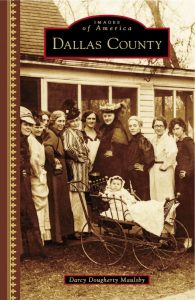 Explore forgotten Iowa history
Explore forgotten Iowa history
I am so excited to bring you this new hardcover, illustrated book, which is the first in-depth, non-fiction history of Dallas County, Iowa, in nearly 80 years!
No Iowa county has influenced American history more than Dallas County. It propelled Harry Truman to an unlikely victory in the 1948 presidential campaign, following a fiery speech he delivered to 100,000 farmers on a sweltering September day at the National Plowing Match near Dexter. Just 15 years earlier, a shoot-out near Dexfield Park marked the beginning of the end for infamous outlaws Bonnie and Clyde and the notorious Barrow Gang.
Dallas County, located just west of Des Moines, has produced several major-league baseball players (among them Bob Feller and Hal Manders), a US congressman (David Young), and Nile Kinnick, the 1939 Heisman Trophy winner and University of Iowa football legend whose grandfather George Clarke, of Adel, served as Iowa’s governor from 1913 to 1917.
Today, Dallas County is one of the fastest-growing counties in America and remains a region of opportunity with a rich heritage of small-town living, farming, coal mining, and the immigrant experience.
My 128-page book from Arcadia Publishing (order signed copies here) is filled with intriguing black-and-white, vintage photos on nearly every page, along with stories from Adel, Perry, Waukee, Granger, Woodward, Dexter, Linden, Minburn, Dawson, Dallas Center, Van Meter, Redfield, Bouton, surrounding rural areas and ghost towns.
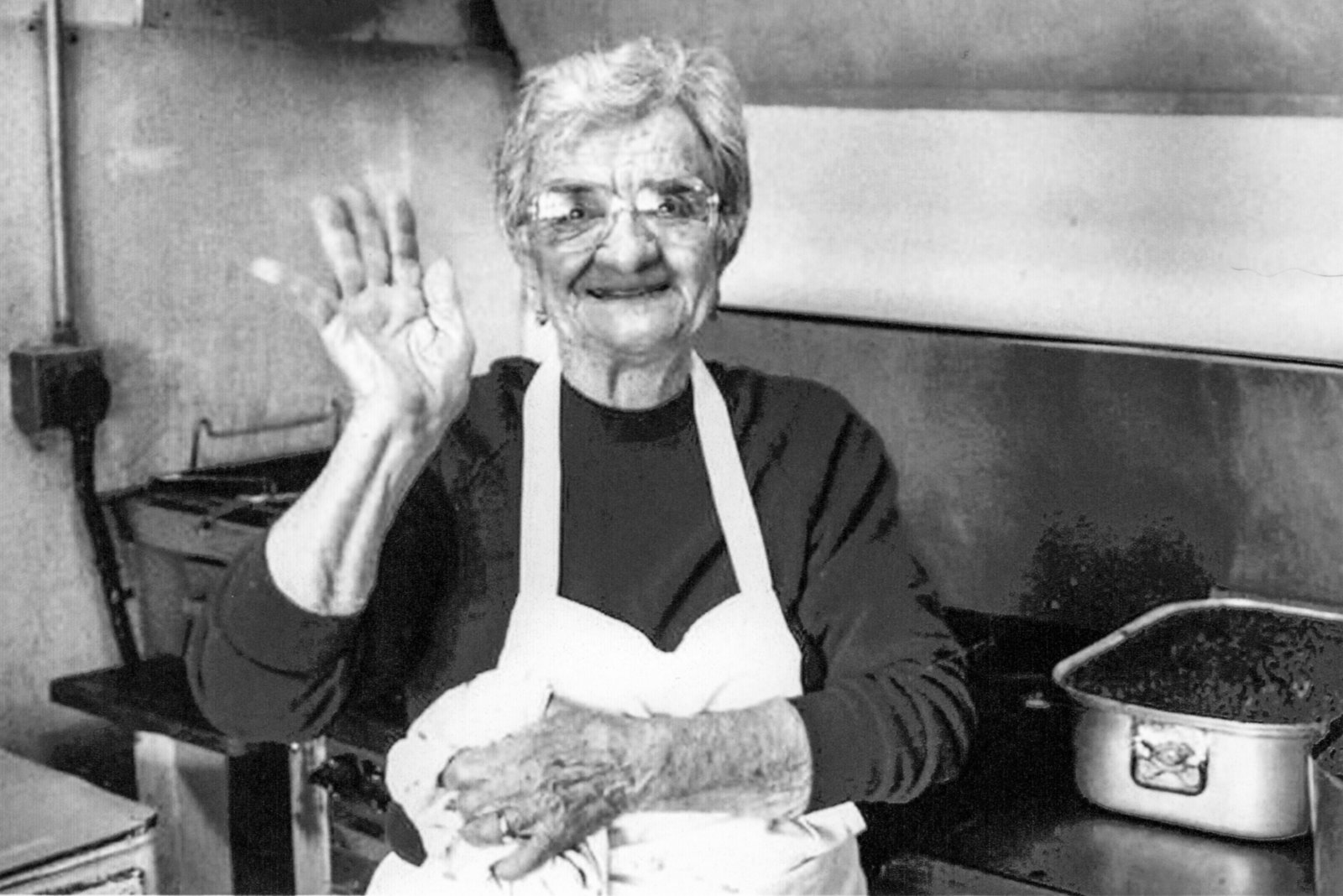
Alice Nizzi, owner of Alice’s Spaghettiland, an Italian restaurant open from 1947 – 2004 in Waukee. Source: Waukee Area Historical Society
Here’s a quick list of highlights that make this Dallas County book unique:
1. Many of the images have been donated from private collections.
2. In the early 20th century, Dallas County was one of the biggest coal-mining areas of Iowa. Much of this history, from Waukee to Woodward, is shared in this new Dallas County book. You can also get the inside story in this guest blog post I wrote for Hometown Heritage in Perry.
3. At least two circuses once made Dallas County their home base, including the famous Orton Bros. three-ring circus, where Five generations of the Orton family thrilled audiences for years. The Yankee Robinson Show, a Midwestern traveling circus, made its winter quarters two miles southeast of Granger. The spacious area also provided a place to bury deceased circus elephants. Granger may be the only Iowa town to claim an elephant graveyard.
4. Minburn’s legendary Singing Wheels roller skating show debuted in 1950 and ran through the early 1960s. Local children, high school students from the Minburn Roller Club and adults all participated in the Singing Wheels’ summer performances, which included a new theme every year, eye-catching costumes, and choreographed routines. These shows attracted thousands of people to the Minburn roller skating rink.
5. The Lake Robbins Ballroom, which opened on November 11, 1931, near Woodward, is still a popular entertainment destination and is one of the few remaining ballrooms in Iowa. The legendary Louis Armstrong performed at Lake Robbins in 1954 and stayed at the Hotel Pattee in Perry, where the most luxurious suite in the hotel is named in his honor.
6. Granger became the focal point of a successful New Deal program inspired by Monsignor Luigi Ligutti, who had served Assumption Church in Granger since 1926. Ligutti felt coal camps were an unsuitable environment for children and looked to the land to address the miners’ economic and social challenges. The 225-acre Granger Homesteads, built in 1935, included 50 modern homes, along with approximately four acres each for raising crops and livestock. In 1936, First Lady Eleanor Roosevelt visited the Granger Homesteads and praised the success of the project.
7. The KKK was active in Dallas County, especially Perry, in the early 1920s. Almost 15,000 people witnessed a KKK parade and semi-public meeting in Perry on May 31, 1924.
8. Dallas County is one of the fastest-growing counties in America and remains a region of opportunity with a rich heritage of small-town living, farming, coal mining, and the immigrant experience.
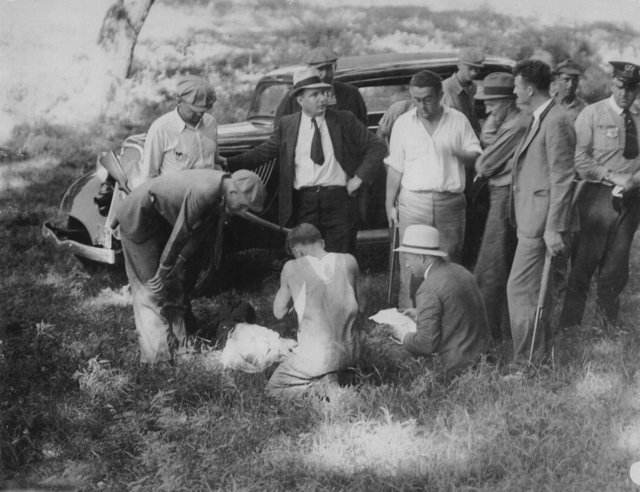
While Bonnie and Clyde escaped, Clyde’s older brother, Buck Barrow (shown lying on the ground), was mortally wounded during a shootout with law enforcement during the early morning hours of July 24, 1933, near Dexfield Park in southern Dallas County. Buck would die a few days later at Kings Daughters Hospital in Perry. Source: Dexter Museum
Click here to order your signed copy today! Priceless memories of Iowa history make a great gift, too.
• Series: Images of America
• Hardcover: 128 pages
• Publisher: Arcadia Publishing (September 4, 2017)
Want more?
Thanks for stopping by. I invite you to read more of my blog posts if you want more more intriguing Iowa stories and history, along with Iowa food, recipes and tips to make you a better communicator.
If you like what you see and want to be notified when I post new stories, be sure to click on the “subscribe to blog updates/newsletter” button at the top of this page. Feel free to share this information with friends and colleagues who might be interested, too.
If you’re hungry for more stories of Iowa history, check out my top-selling “Culinary History of Iowa: Sweet Corn, Pork Tenderloins, Maid-Rites and More” book from The History Press, as well as my Calhoun County” book from Arcadia Publishing, which showcases the history of small-town and rural Iowa. Order your signed copies today! Iowa postcards are available in my online store, too.
Let’s stay in touch. I’m at darcy@darcymaulsby.com, and yettergirl@yahoo.com.
About me:
Some people know me as Darcy Dougherty Maulsby, while others call me Yettergirl. I grew up on a Century Farm between Lake City and Yetter and am proud to call Calhoun County, Iowa, home. I’m an author, writer, marketer, business owner and entrepreneur who specializes in agriculture. Learn more at www.darcymaulsby.com.
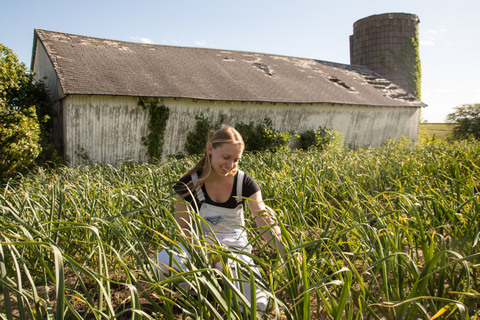
Ultra-Local Eating: Jennifer Miller Guides CSA, Iowa Food Cooperative
Jennifer Miller could hardly believe the question. “When will your bananas be ready?” inquired a central Iowa woman who was buying fresh produce through Miller’s Clarion Sage market garden and community supported agriculture (CSA) business near Waukee.
“People are disconnected from where their food comes from,” said Miller, 30, who noted the woman seeking locally-grown bananas is a well-educated business professional. “I’ve even had people look at our heirloom tomatoes and say, ‘I don’t want those,’ because they think they are GMOs.’”
This disconnect isn’t all that foreign to Miller, who grew up in Highland Park, Illinois, a northern suburb of Chicago. “I had no contact with agriculture in Highland Park,” said Miller, who serves as the Iowa Food Cooperative’s member services coordinator.
Miller did have a connection with Iowa, though, through her paternal grandparents, who lived in the Clarion/Rowan area. Her decision to move to Iowa in 2010 was spurred, in part, by a health challenge and new-found passion for healthy eating.
Miller was diagnosed a number of years ago with celiac disease, a serious autoimmune disorder where consuming gluten can damage the small intestine. “I started caring more about cooking and healthy recipes, because I just wanted to feel better,” said Miller, whose gluten-free and vegan recipes on her blog caught the attention of Martha Stewart Living editors, who invited her to develop recipes for them. “That’s what got me into food and agriculture.”
Food can be so much more interesting
After moving to Iowa, Miller got involved with community gardens in the Des Moines area and became a marketing/communications specialist Iowa Food Cooperative, which operates like an online farmers market. In 2013, Miller and her partner, Cody Kilgore, moved to an acreage on the southwest edge of Waukee’s city limits in Van Meter Township so they could operate their own farm.
“It felt like coming full circle,” said Kilgore, who was raised in rural Missouri, worked in the corporate world for nearly 30 years and was ready for a career switch.
 The couple planted garlic in the fall of 2013 to start their Clarion Sage market garden. The goal? “We believe in ultra-local and want to feed the community around us,” said Miller, who noted that Clarion Sage primarily serves families within a five-mile radius in southern Dallas County.
The couple planted garlic in the fall of 2013 to start their Clarion Sage market garden. The goal? “We believe in ultra-local and want to feed the community around us,” said Miller, who noted that Clarion Sage primarily serves families within a five-mile radius in southern Dallas County.
Today, Miller and Kilgore raise a wide array of vegetables and herbs, including lettuce, squash, cabbage, carrots, garlic, tomatoes, cucumbers, peppers, potatoes and more, including heirloom varieties that can’t be found in most stores. They offer an online ordering system for added convenience.
“Food can be so much more interesting,” Miller said. “Whether you’re sharing a family meal, providing snacks for your kids or making a favorite recipe, one thing’s for sure: the starting point for all these is good food.”
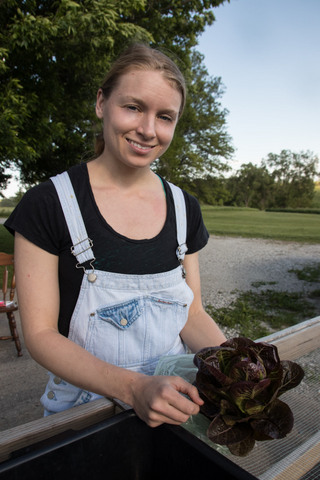
Jennifer Miller displays one of the unique lettuce varieties she grows at Clarion Sage Farm near Waukee.
Six lessons learned about farming and food
As their business evolved, Miller and Kilgore have adjusted their marketing plan to adapt to the often surprising—and sometimes frustrating—buying patterns they’ve observed in the market. The Clarion Sage market garden and CSA have taught them six key lessons, including:
1. Farming is more than production. Raising an abundant crop is just step one, said Miller, who has learned that that marketing and sales are equally important.
2. Mentors matter. “I didn’t grow up gardening, so working for various produce growers in Iowa and beyond taught me so much,” said Miller, who is grateful for leaders like Angela Tedesco who started Turtle Farm near Granger, Jill Beebout from Blue Gate Farm near Chariton and other local food proponents who have mentored her along the way.
3. Buying local adds flavor to life. Clarion Sage’s customers appreciate the “know your farmer” philosophy. Most buyers tend to be in their 30s and 40s with families, or they’re retired and have an interest in good food and time to cook. “Every week we offer our customers about $30 worth of fresh vegetables,” Miller said. “We focus on staple items like lettuce, potatoes, carrots and tomatoes, with the opportunity for more exotic options like stir-fry greens, kale and eggplant.”
4. Catering to consumers can be tricky. While the Clarion Sage CSA is right on Waukee’s doorstep, some consumers don’t want to drive to the farm to pick up vegetables. Some feel they don’t have time, while others don’t like the way the gravel road makes their vehicle dusty. When Miller tried offering delivery, some consumers still rejected this option, citing a lack of time or interest in preparing fresh food. Even full-color newsletters filled with cooking tips and recipes failed to gain much traction with these types of consumers, said Miller, who plans to start selling her produce at the Downtown Farmers’ Market in Des Moines.
5. Urban sprawl is relentless. High-density residential projects are planned for the area near the Clarion Sage’s market garden. “We’re in the bullseye of urban sprawl, which is a challenge,” said Kilgore, who also works as a wedding photographer.
6. Local food pairs well with global flavors. Miller loves ethnic cooking, from Latin American to African. “If you want to add more vegetables to your diet, look to other cultures that don’t have an abundance of meat protein,” said Miller, who encourages people to try vegetables like Cherokee Purple heirloom tomatoes (known for their smoky, complex flavor), fish peppers (which pack more heat), Merlot lettuce (whose dark red leaves offer a mellow flavor) and fingerling potatoes (which taste great fried or roasted).
Food is one of the best parts of life, added Miller, who loves the creativity involved in growing and marketing a crop. “You see a crop through from beginning to end, and you’re producing something that can feed and sustain people. That’s amazing to me.”
Want more?
Thanks for stopping by. I invite you to read more of my blog posts if you want more more intriguing Iowa stories and history, along with Iowa food, recipes and tips to make you a better communicator. If you like what you see and want to be notified when I post new stories, be sure to click on the “subscribe to blog updates/newsletter” button at the top of this page. Feel free to share this information with friends and colleagues who might be interested, too.
If you’re hungry for more stories of Iowa history, check out my top-selling “Culinary History of Iowa: Sweet Corn, Pork Tenderloins, Maid-Rites and More” book from The History Press, as well as my Calhoun County” book from Arcadia Publishing, which showcases the history of small-town and rural Iowa. Order your signed copies today! Iowa postcards are available in my online store, too.
Let’s stay in touch. I’m at darcy@darcymaulsby.com, and yettergirl@yahoo.com.
P.S. Thanks for joining me. I’m glad you’re here.
@Copyright 2017 Darcy Maulsby & Co.
About me:
Some people know me as Darcy Dougherty Maulsby, while others call me Yettergirl. I grew up on a Century Farm between Lake City and Yetter and am proud to call Calhoun County, Iowa, home. I’m an author, writer, marketer, business owner and entrepreneur who specializes in agriculture. Learn more at www.darcymaulsby.com.
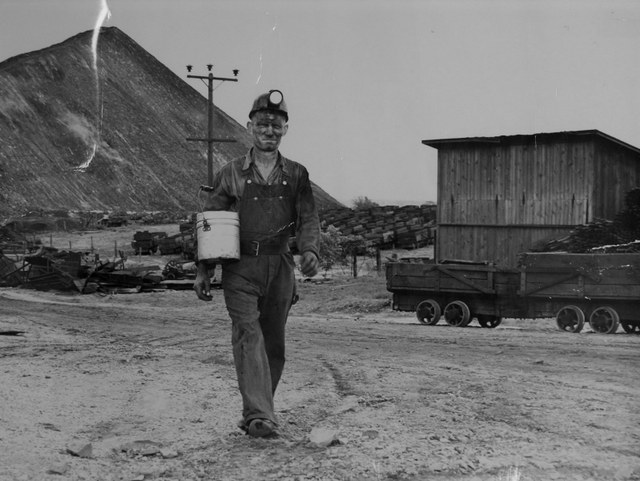
Iowa Underground – How Coal Mining Fueled Dallas County’s Growth
There was a time when Dallas County was one of the most important coal-mining counties in Iowa. While this way of life vanished decades ago, the memories live on, from rooms at the historic Hotel Pattee in Perry to the coal-mining museum in the Waukee Public Library to the many descendants of mining families who still live in the area.
From Moran to Woodward to Waukee, Dallas County thrived with the increased demand a century ago for coal to power train locomotives and heat businesses and homes. Coal was a relatively cheap, plentiful energy source. With ample supplies of coal, Dallas County became a land of opportunity for immigrant miners from Europe and beyond.
Coal mining started in the Van Meter area as early as the 1870s. By the early 1900s, coal was discovered in Des Moines Township east of Woodward, leading to the creation of the Scandia and Phildia mining settlements. After the Phildia mine was abandoned in 1915 and the Scandia mine closed in 1921, miners moved on to the Moran mine, which opened in 1917 west of Woodward.
It’s not on most maps today, but there was a time when Moran was a bit of a boom town.Another mining town–Angus–was an even bigger boom town north of Perry. The Angus & Moran Room at the Hotel Pattee in Perry recalls the history of these areas, which are now little more than ghost towns.
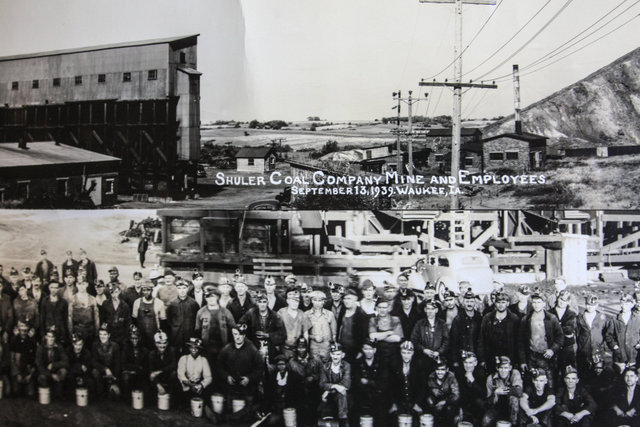
Shuler Coal Mine and employees shown here on September 13, 1939, in Waukee, Iowa. The mine was open from 1921 to 1949. Source: Waukee Area Historical Society
Living with danger
On the opposite side of Dallas County, coal mining also transformed the Waukee area in the early twentieth century. The Harris Mine opened on September 20, 1920, just two and a half miles northeast of Hickman Road in Waukee.
By 1921, the Shuler Coal Company of Davenport, Iowa opened a coal mine on Alice’s Road, one mile east of the Harris Mine. At its peak production, the mine employed more than 450 men.
The Shuler Mine became one of the largest producers of coal in Iowa, and it had one of the deepest mine shafts–387 feet deep. The mine produced coal for Iowa State University, as well as for local railroads, businesses and homes.
The miners worked in the Shuler mine with the help of more than 30 mules, bringing up hundreds of tons of coal per day and millions of tons of coal over the mine’s 28 years of operation. The miners’ work day often started at 6 a.m., and they wouldn’t return home until 4 or 4:30 p.m.
Mining was dangerous, dirty work. Miners used dynamite, as well as heavy picks, to break coal loose from the coal veins. When the siren blew, it was a sign that a miner was in trouble, or there had been a cave-in.
“I can remember the whistle blowing in succession to let people know there had been an accident,” noted Angelo Stefani, whose uncle was killed in a mining accident. “I can also vividly member women coming out of their homes to see what happened. They were hysterical.”
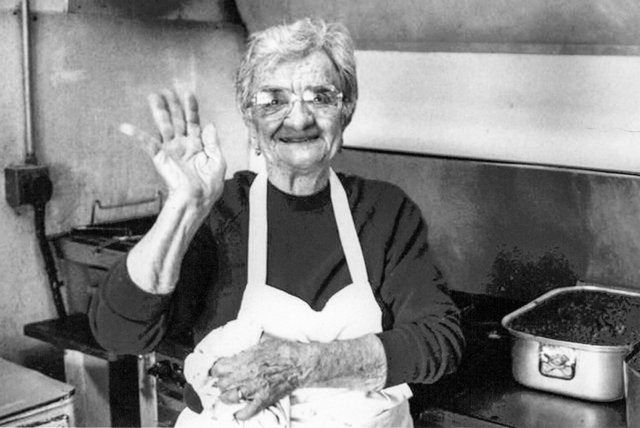
Alice Nizzi was the founder and owner of the beloved Alice’s Spaghettiland, an Italian restaurant open from 1947 – 2004 in the Waukee area. Source: Waukee Area Historical Society
Life in Waukee’s coal mining community
The Shuler mining camp was home to Italians, Croatians and people of other ethnicities. Most families lived in small, simple houses with no running water, but they often raised chickens and tended enormous gardens where they grew a variety of vegetables.
Work wasn’t always steady. Dallas County’s coal mines often closed in the summer, when demand for coal dropped off in the warmer months. Miners would often work for local farmers or do odd jobs around the community to help pay the bills.
Some of the miners’ wives, especially those in Italian families, worked at local restaurants like Rosie’s and Alice’s Spaghettiland near Waukee to supplement the family’s income. Alice Nizzi (1905–1997) opened Alice’s Spaghettiland in the Shuler mining community just north of Hickman Road in 1947. The restaurant’s waitresses were required to wear white, starched uniforms. Alice’s became a destination and Waukee-area institution for decades until it closed in 2004.
The Waukee Area Historical Society hosted a fundraising dinner in the spring of 2014 featuring Alice’s spaghetti and Italian salad. Hundreds of people now attend this fun event, which has been held each April for the past few years.
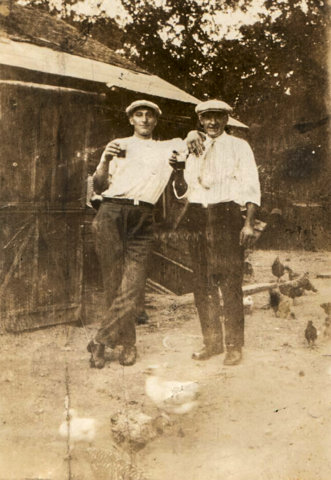
Terzo Fiori (left) and Pete Nizzi enjoyed tasting their homemade wine. Excitement spread through Waukee’s mining camps when grapes were imported from California and shipped by train in two boxcars so families could make their yearly supply of red wine.
Remembering the grape trains
For Italian families in the Shuler mining camp, one of the highlights of the year was the arrival of the annual trainload of grapes for making homemade wine.
“Excitement spread throughout the camp when the train arrived, and most of the people from the mining camp came to help unload the box cars,” said Gilbert Andreini, whose memories are recorded at the coal mining museum at the Waukee Public Library. “It was like a celebration.”
The end of an era
By the time the Shuler mine closed in 1949, Iowans began looking to energy sources other than coal for home use, such as electricity, natural gas and heating oil. In addition, the railroads were converting from steam to diesel engines, reducing the need of coal for locomotives.
While Dallas County’s coal mines have vanished into history, those who grew up in the mining camps will never forget how these areas grew into close-knit communities. Everyone knew everyone else and helped each other out, recalled Bruno Andreini.
“I’m very proud of those times. Anyone from that community is like a brother or sister to me. Even though we were poor, we had things that were far more valuable than money.”
Note from Hometown Heritage
I originally wrote this as a guest blog post for Hometown Heritage in Perry. Here’s a note from Hometown Heritage:
If you’d like to meet Darcy, hear more of her stories, and enjoy some Dallas County-inspired snacks, Darcy will be speaking at Hotel Pattee on September 11th, 2017, from 7 – 9 pm as part of Hometown Heritage’s fall programming series. For more information on this, please visit our website.
You can also learn more about Darcy on her website (www.darcymaulsby.com), and her new Dallas County book is available for pre-order on Amazon.
Want more?
Thanks for stopping by. I invite you to read more of my blog posts if you want more more intriguing Iowa stories and history, along with Iowa food, recipes and tips to make you a better communicator. If you like what you see and want to be notified when I post new stories, be sure to click on the “subscribe to blog updates/newsletter” button at the top of this page. Feel free to share this information with friends and colleagues who might be interested, too.
If you’re hungry for more stories of Iowa history, check out my top-selling “Culinary History of Iowa: Sweet Corn, Pork Tenderloins, Maid-Rites and More” book from The History Press, as well as my Calhoun County” book from Arcadia Publishing, which showcases the history of small-town and rural Iowa. Order your signed copies today! Iowa postcards are available in my online store, too.
Let’s stay in touch. I’m at darcy@darcymaulsby.com, and yettergirl@yahoo.com.
P.S. Thanks for joining me. I’m glad you’re here.
@Copyright 2017 Darcy Maulsby & Co.
About me:
Some people know me as Darcy Dougherty Maulsby, while others call me Yettergirl. I grew up on a Century Farm between Lake City and Yetter and am proud to call Calhoun County, Iowa, home. I’m an author, writer, marketer, business owner and entrepreneur who specializes in agriculture. Learn more at www.darcymaulsby.com.

Lightner on Leadership: “Everyone Has Something to Give”
My friend Deb Lightner calls it her ah-ha moment. While she was well acquainted with Stewart Memorial Community Hospital (SMCH) in Lake City through her 12 years of service on the hospital board, it became personal when a good friend received care at SMCH.
“My friend received a survey from SMCH and was asked if there were any staff members she’d like to lift up for special recognition,” said Lightner of Lohrville, whose friend had been diagnosed with breast cancer. “My friend said she couldn’t single out any one person, because they were all wonderful.”
This experience highlighted the value of compassionate care close to home and reinforced Lightner’s commitment to SMCH, where she served on the board from 2005 to her retirement this spring.
“It’s wonderful to have access to high-quality healthcare in our community. Having SMCH here also does so many other good things for our area, from attracting medical and business professionals to providing good jobs. Our communities also benefit when people connected with SMCH fill leadership roles, from city councils to school boards.”
Lightner is a true servant leader, said Cynthia Carstens, president/CEO of SMCH. “Deb has the skills, knowledge and heart to tackle challenges and make sure that needs are addressed. She adheres to the principles of listening, empathy, foresight, shared decision making, a willingness to challenge the status quo and building community.”
Carstens cited how Lightner recognized a need for a Meals on Wheels program for the Lohrville community. “She worked with our organization to get that set up and delivered many of those meals herself until there no longer was a need.”
Five ways SMCH is raising the bar
This spirit of service is reflected throughout SMCH, a critical access hospital affiliated with UnityPoint Health. Lightner is proud that SMCH is raising the bar in five keys ways, including:
1. Culture change. SMCH worked with the Studer Group® to build a sustainable culture that promotes accountability, fosters innovation and consistently delivers a great patient experience. This culture helps attract top talent to SMCH, a non-profit organization that employs approximately 185 full-time staff in Lake City, Lake View, Rockwell City and Gowrie. “Other hospitals around Iowa are amazed at SMCH’s ability to recruit doctors and other medical professionals,” Lightner said.
2. Diverse leadership. Strong leadership is the key to any successful organization, said Lightner, who farms with her family near Lohrville. Along with the SMCH leadership team, the SMCH board includes people with a diverse array of skills. “The board has included farmers, educators, pastors, small-business owners, bank presidents and others who care about the community and the organization,” Lightner said. “Good board members also show a willingness to learn, ask questions and speak up.”
3. Inclusion. While Lightner encourages people to serve on the SMCH board, there are other ways to get involved. SMCH offers a hospital auxiliary group where members can volunteer at the SMCH gift shop, help with fundraising events and more.
4. Responsive solutions. Wellness and preventative healthcare are priorities at SMCH. “Many of SMCH’s Lunch Connection educational programs and other wellness programs are developed in response to issues the community cares about,” Lightner said.
5. Forward focus. As medical technology advances and outpatient services become much more prevalent, this presents complex, challenging issues for the hospital, said Lighter, who has a strong background in finance. “While we’re still one of the hospitals that delivers babies, the trend away from in-patient care means SMCH is looking at new ways to best serve our community and do it cost-effectively.”
Lightner remains a strong supporter of SMCH, even though her board term is completed. “It has been an honor to work with Deb, who is one of the strongest women I know,” Carstens said.
Lightner is currently exploring volunteer opportunities with the Peace Corps. “I never view community service as a chore,” she said. “Everyone has something to give.”
This originally appeared in the Hometown Pride section of the Fort Dodge Messenger, June 25, 2017.
Want more?
Thanks for stopping by. I invite you to read more of my blog posts if you want more more intriguing Iowa stories and history, along with Iowa food, recipes and tips to make you a better communicator. If you like what you see and want to be notified when I post new stories, be sure to click on the “subscribe to blog updates/newsletter” button at the top of this page. Feel free to share this information with friends and colleagues who might be interested, too.
If you’re hungry for more stories of Iowa history, check out my top-selling “Culinary History of Iowa: Sweet Corn, Pork Tenderloins, Maid-Rites and More” book from The History Press, as well as my Calhoun County” book from Arcadia Publishing, which showcases the history of small-town and rural Iowa. Order your signed copies today! Iowa postcards are available in my online store, too.
Let’s stay in touch. I’m at darcy@darcymaulsby.com, and yettergirl@yahoo.com.
P.S. Thanks for joining me. I’m glad you’re here.
@Copyright 2017 Darcy Maulsby & Co.
About me:
Some people know me as Darcy Dougherty Maulsby, while others call me Yettergirl. I grew up on a Century Farm between Lake City and Yetter and am proud to call Calhoun County, Iowa, home. I’m an author, writer, marketer, business owner and entrepreneur who specializes in agriculture. Learn more at www.darcymaulsby.com.
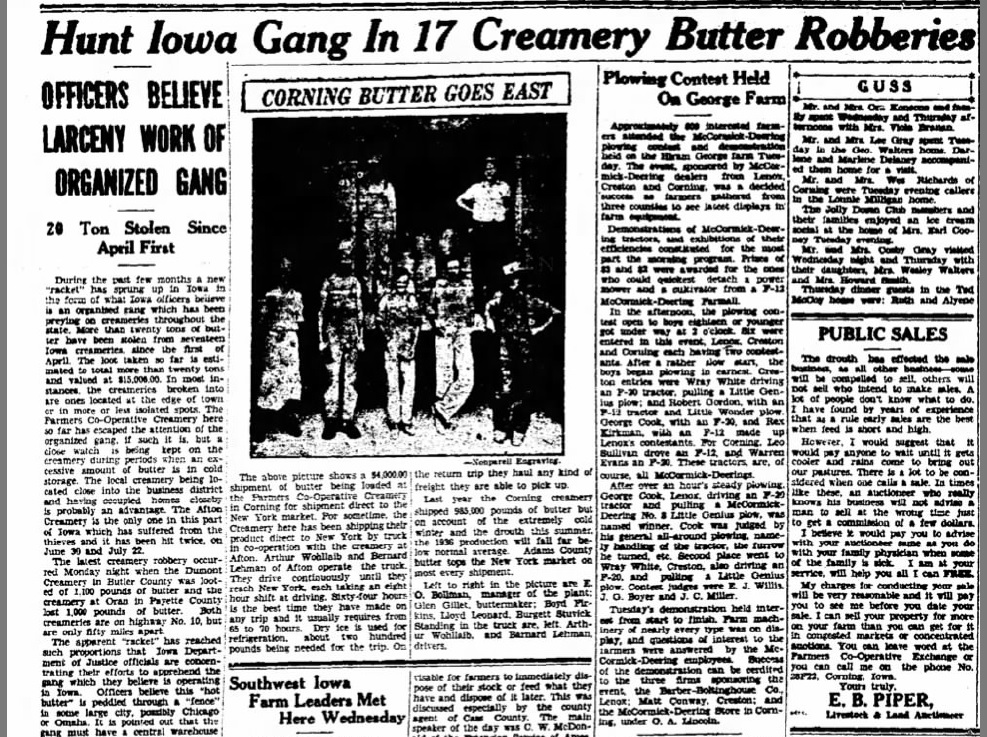
Busting the Iowa Butter Gang
“Hey, did you ever hear of the Iowa Butter Gang?” It’s the last question I expected to hear during my recent “Culinary History of Iowa” book signing in West Des Moines, and it definitely caught my attention.
It came from Jan Kaiser, a former Des Moines librarian who had first “encountered” the nefarious gang a few years ago through research into 70+-year old newspaper archives.
Turns out that crime came in many forms during the Great Depression. Back then, butter was big business in rural Iowa. Not only was Iowa a leading dairy state, but hundreds of Iowa creameries produced high-quality butter that helped make Iowa a top shipper of butter into the New York City area, I learned recently from Iowa Secretary of Agriculture Bill Northey.
While some Depression-era criminals robbed banks, some thieves in rural Iowa opted to rob creameries. A headline in the Aug. 6, 1936, edition of the Adams County Free Press newspaper announced, “Hunt for Iowa Gang in 17 Iowa Creamery Butter Robberies: Officers Believe Larceny Work of Organized Gang.”
The article noted that during the spring and summer of 1936, a new “racket” had sprung up in Iowa in the form of an organized gang that preyed on creameries throughout the state. By early August 1936, more than 20 tons of butter had been stolen from 17 Iowa creameries since early April 1936. “The loot taken so far is estimated to total more than 20 tons and is valued at $15,000,” noted the news article.
In most cases, the creameries that were broken into were located on the edge of town or in isolated spots. The gang’s targets in 1936 included:
• April 3, Palmer, 2,172 pounds
• April 8, Fenton, 3,440 pounds
• May 15, Fenton, 2,080 pounds
• May 28, Edgewood, 630 pounds
• June 4, Britt, 5,184 pounds
• June 12, Kimballton, 4,000 pounds
• June 20, Coulter, 4,095 pounds
• June 30, Afton, 2,200 pounds
• July 1, Hampton, 2,209 pounds
• July 3, Hubbard, 7,488 pounds
• July 8, Palmer, 3,553 pounds
• July 11, Randall, 2,304 pounds
• July 22, Afton, 2,764 pounds
• July 30, Nashua, 1,500 pounds
• July 31, Masonville, 2,228 pounds
• August 3, Dumont, 1,100 pounds
• August 3, Oran, 1,000 pounds
“It is believed that before each burglary, the creamery is selected by the gang and careful plans made,” stated the Adams County Free Press. “The robbers are evidently expert burglars and experience little difficulty in breaking into creameries. They use a truck and are gone with their loot before local officials know there has been a burglary.”
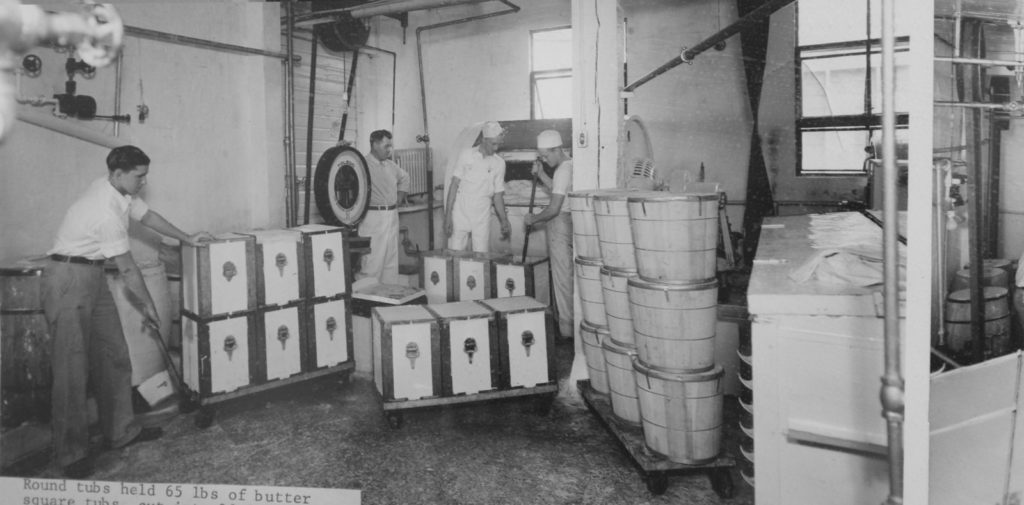
Butter making was big business in small-town creameries across Iowa in the 1930s, including this creamery in Somers (featured in my Calhoun County book). George Smith built Somers’ first creamery was built in 1900. In 1913 S. P. Petersen purchased and updated the creamery, which became a major business in town for many years. The round tubs in this photo each held 65 pounds of butter. This butter was sold to area stores. In Fort Dodge alone, about 2 tons of butter was sold each week. Butter from Somers was also sent to New York.
Peddling “hot butter”
The writer speculated that the gang must have a central warehouse, since butter is highly perishable. The apparent racket reached such epic proportions that Iowa Department of Justice officials concentrated their efforts to apprehend the gang. “Officers believe this ‘hot butter’ is peddled through a ‘fence’ in some large city, possibly Chicago or Omaha,” the writer noted.
(A fence is someone who knowingly buys stolen property for later resale, sometimes in a legitimate market. The fence acts as a middleman between thieves and the eventual buyers of stolen goods who may not be aware that the goods are stolen.)
The article continued, “The Farmers Co-operative Creamery here [in Corning] so far has escaped the attention of the organized gang, but a close watch is being kept on the creamery during periods when an excessive amount of butter is in cold storage.”
It’s no wonder locals were keeping a close watch. The Farmers Co-op Creamery shipped thousands of dollars of butter each year to the New York market. The Adams County Free Press reported that two local truck drivers would each take eight-hour driving shifts and drive straight through from Iowa to New York. The best time they made from Iowa to New York was 64 hours, although the trip usually took 65 to 70 hours.
About 200 pounds of dry ice were used for refrigeration during the trip. On the return trip, the drivers hauled any kind of freight they were able to pick up. In 1935, the Corning creamery shipped 985,000 pounds of butter, noted the newspaper article. Due to the harsh winter and summer drought of 1936, however, that year’s production was expected to fall far below average—a fact that made the butter robberies of 1936 even more devastating in rural Iowa.
Finally—a big break in the case
By August 1936, officers with the Iowa State Patrol (formed just a year earlier in 1935) and a group of northern Iowa vigilantes and deputy sheriffs had been driving the secondary and dirt roads nightly for the last two months, trying to catch the butter gang, according to the Des Moines Tribune (the capital city’s afternoon newspaper that ended in 1982).
Some promising leads ended in disappointment. In the summer of 1936, officers arrested Harvey Mighell of Holstein on suspicion that he was connected with the butter gang. He was taken to Audubon, where he was questioned and later released under $2,000 bond. Mighell denied having anything to do with the Iowa butter thefts.
Law enforcement officials got a big break, however, by late August 1936. A headline in the Aug. 29, 1936, edition of the Des Moines Tribune proclaimed “Iowa Butter Gang Crushed.”
Turns out an Omaha gang of six men and one woman stole some $30,000 worth of butter, cheese and eggs in a string of more than 30 robberies across Iowa in 1936. (The pilfered dairy products were worth nearly $525,000 in today’s money.) The butter was trucked to Omaha and was sold through a fence.
“Virtually every sheriff in northern Iowa has been on the case as well as several detectives of the Omaha police department and other Iowa town police departments,” the reporter noted.
Iowa prosecutors charged the gang with 32 robberies. Detectives recovered 70 tubs of butter, the Tribune reported, 66 of which had been stolen from a creamery in Wesley. All the cheese was lifted from Ionia, the story reported. Law enforcement officials took the dairy products and sold them through legitimate channels to packers in Omaha.
“Capture of the Butter Gang was the climax of one of the greatest Iowa manhunts in recent years,” officials told the newspaper.
One more try?
The story wasn’t over, though. Less than five years later, one of the original butter gang members tried to revive the scheme. Under the headline “Butter Theft Gang Thwarted,” the Jan. 15, 1941, issue of the Mason City Globe-Gazette reported the arrest of Bryon Green, 32, of Sioux City. “R.W. Nebergall, chief of the Iowa Bureau of Investigation, believed that Green was attempting to set up a new ‘butter theft gang’ in Iowa,” stated the article.
On Dec. 13, 1940, Green had been released from prison in Stillwater, Minnesota, after serving three and a half years for burglary. Within a few weeks of his release from prison, Green was arrested by Chicago police, who accused him of entering the Masonville, Iowa, creamery on January 9, 1941, and shipping 1,230 pounds of stolen butter to a Chicago firm.
Thus ended the saga of the infamous butter gangs that terrorized rural Iowa in the 1930s. Their nearly forgotten story faded into history, along with the small-town creameries that once inspired their notorious crime spree.
Want more?
Thanks for stopping by. I invite you to read more of my blog posts if you want more more intriguing Iowa stories and history, along with Iowa food, recipes and tips to make you a better communicator. If you like what you see and want to be notified when I post new stories, be sure to click on the “subscribe to blog updates/newsletter” button at the top of this page. Feel free to share this information with friends and colleagues who might be interested, too.
If you’re hungry for more stories of Iowa history, check out my top-selling “Culinary History of Iowa: Sweet Corn, Pork Tenderloins, Maid-Rites and More” book from The History Press, as well as my Calhoun County” book from Arcadia Publishing, which showcases the history of small-town and rural Iowa. Order your signed copies today! Iowa postcards are available in my online store, too.
Let’s stay in touch. I’m at darcy@darcymaulsby.com.
P.S. Thanks for joining me. I’m glad you’re here.
@Copyright 2017 Darcy Maulsby & Co.
About me:
Some people know me as Darcy Dougherty Maulsby, while others call me Yettergirl. I grew up on a Century Farm between Lake City and Yetter and am proud to call Calhoun County, Iowa, home. I’m an author, writer, marketer, business owner and entrepreneur who specializes in agriculture. Learn more at www.darcymaulsby.com.
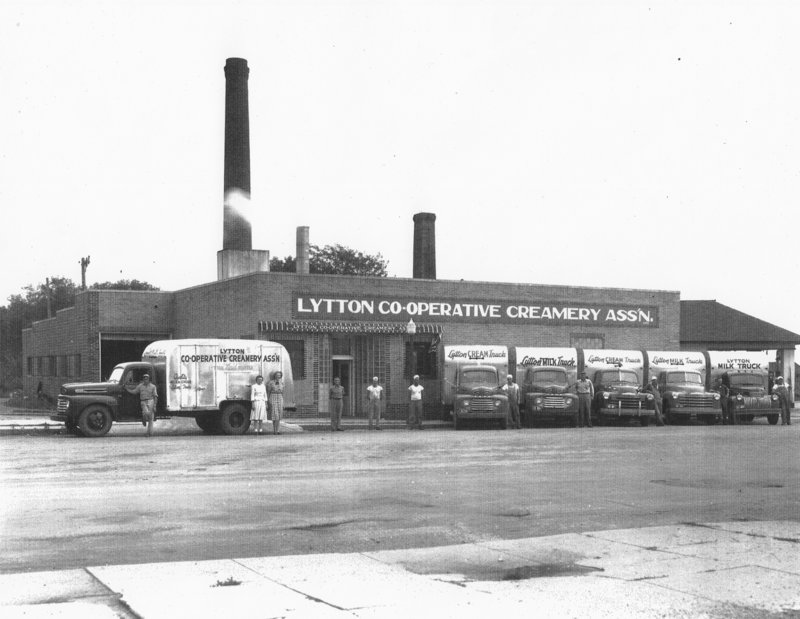
The Lytton Cooperative Creamery Association (featured in my Calhoun County book) was organized in June 1933. Capital for the new venture came from local farmers, who subscribed for shares on a basis of $5 per cow. In 1936, the creamery produced 110,000 pounds of butter. Grade A milk was processed, bottled, and distributed under the name “Lytton Maid” until this was discontinued in 1963. The plant closed in August 1979.

Remembering Ambassador Branstad’s Legacy from the 1980s Farm Crisis in Iowa
A morning talk-show host on WHO Radio in Des Moines posed an interesting question when former Iowa Governor Terry Branstad was confirmed as the U.S. ambassador to China on May 22, 2017. The broadcaster asked what might define Branstad’s enduring legacy, and he suggested it may be Branstad’s service during the 1980s Farm Crisis.
The more I thought about it, the more I agreed. I was just a kid in the 1980s Farm Crisis and didn’t really understand what was happening, but I knew it was bad. I remembering writing a poem about the Farm Crisis in 7th grade in 1987 for my contribution for a time capsule that was buried in Lake City.
Sheltered as I was from my family’s financial realities, I had no idea my dad only made $800 one year during the peak of the Farm Crisis. Still, that was far better than what some other farmers were experiencing. As one farmer told me during a recent interview about his family’s Century Farm, the thing he dreaded the most during the Farm Crisis was the phone ringing. “You never knew who it might be or what bad news it might be,” he said.
The Farm Crisis was just starting its brutal transformation of Iowa agriculture when Terry Branstad was first elected governor of Iowa in 1982. This new era was a far cry from the heady go-go days of the 1970s, when agriculture was booming, and making good money in farming was not only possible, but almost easy.
Farmers were hurting
By the early 1980s, however, a combination of national and international factors, including a Federal Reserve Board policy of high interest rates to fight inflation and a grain embargo against the Soviet Union, devastated the farm economy. Crop prices to dropped below the cost of production. Land values plummeted. Countless rural Iowa banks closed.
“All of us who lived in Iowa at the time saw friends and neighbors lose their family farms and struggle with what to do next to earn a living,” said Iowa Sen. Charles Grassley, who recalled the Farm Crisis in a 2015 press release he issued about Branstad becoming the longest-serving governor in the nation’s history.
By the time Branstad took office as governor, individual farmers across the state were hurting. No one really wanted to believe it was as bad as it was, but agriculture was in serious trouble.
In early December 1985, an eastern farmer who was apparently distraught over his finances killed the president of his bank, his neighbor and his own wife before he killed himself. Dale Burr, 63, who farmed near Lone Tree, made national headlines after he walked into the Hills Bank and Trust Company and shot its president, John Hughes, with a 12-gauge shotgun.
With farmers in desperate need of help, the Iowa governor’s office created the Rural Concern Hotline to provide assistance where possible. The state tried to help producers with debt restructuring as much as it could.
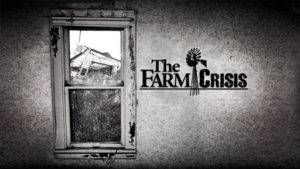 As the Farm Crisis deepened by the mid-1980s, however, one of the biggest frustrations was the seeming indifference from officials in Washington, D.C. “President Reagan was very supportive and sympathetic,” Branstad recalled in an Iowa Public Television documentary about the Farm Crisis. “Unfortunately, David Stockman, who worked for him and who was the director of the Office of Management and Budget, was pretty cavalier in his attitude. Considering all the stress and challenges we were going through in Iowa, we didn’t just take no for an answer.”
As the Farm Crisis deepened by the mid-1980s, however, one of the biggest frustrations was the seeming indifference from officials in Washington, D.C. “President Reagan was very supportive and sympathetic,” Branstad recalled in an Iowa Public Television documentary about the Farm Crisis. “Unfortunately, David Stockman, who worked for him and who was the director of the Office of Management and Budget, was pretty cavalier in his attitude. Considering all the stress and challenges we were going through in Iowa, we didn’t just take no for an answer.”
Hollywood goes to Congress, Branstad creates a new environment for business
Even Hollywood took note. Two popular films, Country and The River, drew the eyes of America to the plight of the nation’s farm families. Soon, Hollywood stars like Jessica Lange were testifying before Congress about the Farm Crisis.
Far from Congress and Hollywood, however, Branstad relied on his small-town and farm background to lead Iowa through the Farm Crisis.
“The state needed men and women with vision and ambition to pull the economy out of the doldrums,” Grassley noted. “It needed people who could see the potential for farmers to add value to their operations and for Iowa to diversify its economy. Terry Branstad was one of those people.”
Branstad was at the forefront of creating a new environment to do business. He welcomed and actively encouraged innovation that would capitalize on Iowa’s bedrock work ethic and strong schools. As a result, agriculture continues to be a mainstay of the Iowa economy while providing the economic engine that benefits many other employment sectors, including renewable energy, manufacturing, crop research and much more.
Ironically, some of Branstad’s actions in the Farm Crisis didn’t seem that significant at the time but would benefit agriculture decades in the future. In 1985, while still in his first term as governor, Branstad welcomed Xi Jinping, who was then a Communist party official and feed cooperative director from Hebei Province. Xi Jinping, who is now the president of China, spent several days in Muscatine in 1985 leading a delegation of Chinese government officials who saw Iowa agriculture first-hand and became acquainted with Iowa farm families.
That visit 32 years ago forged an unlikely bond between China and rural Iowa that endures today. I believe this bodes well for rural Iowa and our role in the global economy as Branstad serves as America’s ambassador to China.
It’s also a large feather in the cap of an Iowa farm kid from Leland, population 284, whose legacy as Iowa’s governor and ambassador to China can’t be told accurately without looking back to those painful, pivotal days of the 1980s Farm Crisis.
Want more?
Thanks for stopping by. I invite you to read more of my blog posts if you want more more intriguing Iowa stories and history, along with Iowa food, recipes and tips to make you a better communicator. If you like what you see and want to be notified when I post new stories, be sure to click on the “subscribe to blog updates/newsletter” button at the top of this page. Feel free to share this information with friends and colleagues who might be interested, too.
Let’s stay in touch. I’m at darcy@darcymaulsby.com.
P.S. Thanks for joining me. I’m glad you’re here.
@Copyright 2017 Darcy Maulsby & Co.
About me:
Some people know me as Darcy Dougherty Maulsby, while others call me Yettergirl. I grew up on a Century Farm between Lake City and Yetter and am proud to call Calhoun County, Iowa, home. I’m an author, writer, marketer, business owner and entrepreneur who specializes in agriculture. Learn more at www.darcymaulsby.com.
This column first appeared in Farm News in June 2017.
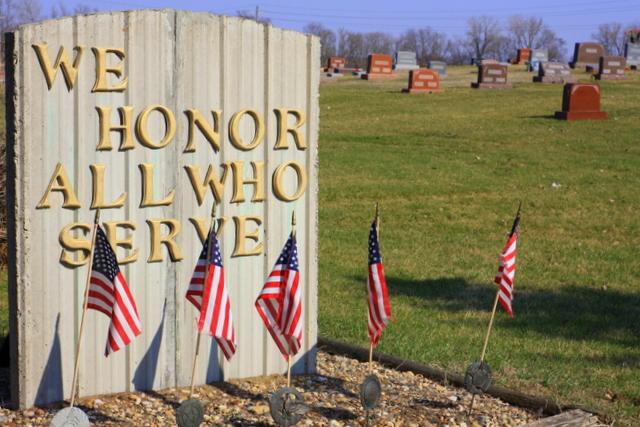
How to Thank Veterans for Their Military Service
It shocked me the first time it happened. I was sitting in the living room of a World War 2 veteran and was interviewing him for a Memorial Day story. I felt humbled and grateful to hear his stories as he described the places he’d served, the hardships he had experienced, his fears and his perspective on life all these years later. What stunned me was his family’s reaction.
“That’s the first time I’ve heard most of those stories,” said his daughter who had stopped by during the interview.
This wouldn’t be the first time I’d have this experience. I’ve discovered that sometimes veterans won’t open up, even to loved ones, because the memories are too painful, but sometimes the reasons are much simpler. “I tried sharing these stories a few times, but my family didn’t really understand what I was talking about and didn’t ask any questions, so I just gave up,” one Iowa veteran told m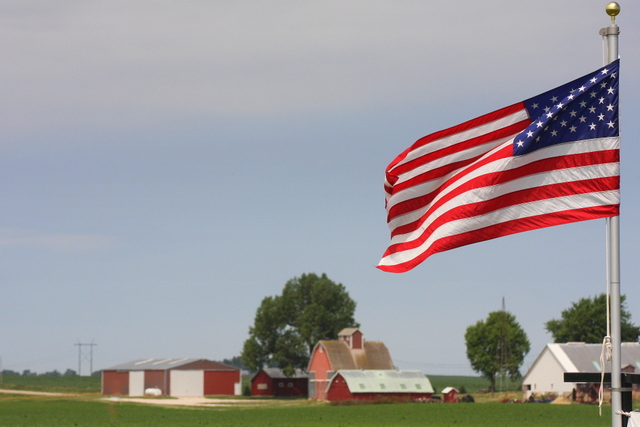 e. “I decided it would be easier to talk about these things with other veterans.”
e. “I decided it would be easier to talk about these things with other veterans.”
This got me thinking—what’s the right way to talk to veterans, whether you want to thank them or hear more of their stories? If you’re like me, maybe you’re not even sure how to start the conversation.
That’s why I asked Marine Corps veterans James Nash and Jay Lippmeier for their insights. I first connected with Nash and Lippmeier after they came to Lakota, Iowa, for Hunting with Heroes. This amazing program, which was created by Bernie and Jason Becker, invites Marines from the Wounded Warrior Battalion at Camp Lejeune, North Carolina, to the Midwest each November for an all-expenses-paid trip to find some peace in the Iowa countryside and enjoy some prime pheasant hunting.
Captain Nash is now retired from the Marine Corps and lives in Oregon. He enjoys returning to Iowa to help create a sense of camaraderie and comfort for the Marines who participate in Hunting with Heroes for the first time. Staff Sergeant Lippmeier, who participated in the 2016 Hunting with Heroes event, is a Cincinnati, Ohio, native who recently retired from the Marines Corps and appreciates the chance to spend more time with his family, including his children.
I’d like to thank Captain Nash and Staff Sergeant Lippmeier for their friendship and for letting me share their insights in my May 26, 2017, Farm News column, which I’m also sharing here:
Q: Any tips on what people can say to veterans to start the conversation?
Nash: When folks say thanks for your service, it does two things to me. I typically sense their gratitude, but I also sense that sometimes people issue that canned phrase to reassure their sense of patriotism to themselves, and they are not interested in what exactly it is they’re thanking me for.
When I talk to vets, I ask then what branch they were in and what their job was. Army vets often respond with a numerical designation for their military occupational specialty (MOS), like 11B. That’s fine, but ask what that means, where were they stationed, what unit did they serve with? Did they deploy? Do they still keep in touch with anyone they served with?
If these questions don’t begin a conversation, the veteran likely doesn’t want to talk. Respect that. That’s the time to end the conservation and say thank you. It won’t be hollow because, now you both know what you are thanking the veteran for.
Lippmeier: Treat veterans like other people you’ve just met. Ask them what they do/did in the military, like their branch of service and their military occupation. Then use follow-up questions, especially if you don’t understand the answers or certain verbiage the military uses. I would much rather explain something to someone than have them have no clue what I’m talking about.
Upon first meeting someone, most vets I know have no problem talking about what branch they were in or what job they did without going into a lot personal details. Most vets will start to open up a bit as they get more comfortable. If someone doesn’t want to talk about his or her service, respect that. Everyone has bad days sometimes.
Q: Are there any things people shouldn’t ask?
Nash: I don’t like when folks asked me how many people I killed. It’s not like I wrote hash marks in my journal. But if they do ask, that’s better than if they are afraid to ask. When I sense people don’t have the courage to ask about my experiences, it makes me compare that lack of courage to the bravery I witnessed in the men I served with. Then I wonder why we risked so much for that person’s freedom.
I remember that it’s always incumbent upon the brave to protect the fearful, for a few to sacrifice for the many, but it doesn’t feel good when I compare the fear of driving through a minefield, getting shot at by snipers or having mortars explode around me to someone’s fear of simply asking me what that was like.
Lippmeier: The number one question people shouldn’t ask is, “Have you ever killed anyone?” That is by far the question I ‘ve been asked the most, and it’s definitely a loaded question and a very personal one, as well.
Besides that, most vets will let you know if they don’t want to answer a certain question, or they may shut down if a question strikes a nerve. Again, just respect that and move on. I’m sure there are questions that would make anyone uncomfortable, so just use your best judgment and treat vets with the same respect you would treat any person you just met.
Q: Are there any things you wish people knew about the military or veterans?
Nash: Not every service member experiences combat. Most don’t. It’s important to not discount their sacrifice in the time they spend away from their loved ones and the relative hazards to their job. Also, when it comes to injuries, you must understand that paralysis and amputations are dramatic, but many injuries are unseen. A lot of folks look at me and say things like, “Well, it looks like you are doing just fine.” To which I think, yeah, it’s just my brain and spine that were damaged. No big deal. But I don’t say that.
Lippmeier: The biggest thing that I wish people knew is that everyone’s military experience will vary. Just because someone was in the military doesn’t mean they were in combat. The majority of veterans don’t see combat, but just because a vet wasn’t in combat doesn’t make their service less honorable. Without vets that didn’t see combat, the combat guys wouldn’t be able to do their jobs.
Another thing is that not all injuries are visible. You can spot guys who are missing limbs or using wheelchairs or other devices, but the majority of vets who are injured have “invisible wounds.” Just because I have 10 fingers and 10 toes doesn’t mean I don’t have five herniated discs, scar tissue in my brain, severe post-traumatic stress disorder, and a laundry list of other injuries. So just realize there can be a plethora of things going on with someone even though he or she looks ok.
Q: Any other tips for how civilians can communicate better with veterans?
Lippmeier: Treat veterans like normal people, but realize they’ve had a lot of different experiences than non-vets. Just be patient, and veterans will usually open up after some time. It’s sometimes hard for veterans to let someone in their life, because they may have seen or had someone close to them be violently torn from their life.
Nash: Know that if you ask these questions, the answers may make you uncomfortable. Try to compare your discomfort with the experience of the person you are speaking to, and hopefully it will give you the guts the hang in there and have the conversation. Let veterans know their sacrifices were worth the cost.
I salute our veterans
I salute America’s military men and women, including Captain Nash and Staff Sergeant Lippmeier, and am forever grateful to those who trust me enough to share their stories. We must never forget their service and their sacrifices. (Click here to hear Captain Nash, in his own words, talk about everything from hunting to his experiences as an officer to being awarded the Purple Heart.)
Some veterans will tell you that Veterans’ Day is the time to member those who survived, while Memorial Day is to honor those who have died. That’s true, yet Memorial Day to me means a time to honor all our military personnel, including those who have passed away, veterans who are still with us and those serving on active duty.
A respect for all veterans was instilled in me from childhood as my parents took me each May to the Lake City Cemetery for the Memorial Day service. The roll call of the deceased is one of the most poignant parts of the service. As I listen for the name Henry C. Nicholson, an ancestor of mine who fought in the Civil War, I also glance around the crowd and see the veterans who are still with us. These men and women are my friends and neighbors who came back to Iowa to farm, work hard, raise a family and give back to their community. These are the everyday people who make America work.
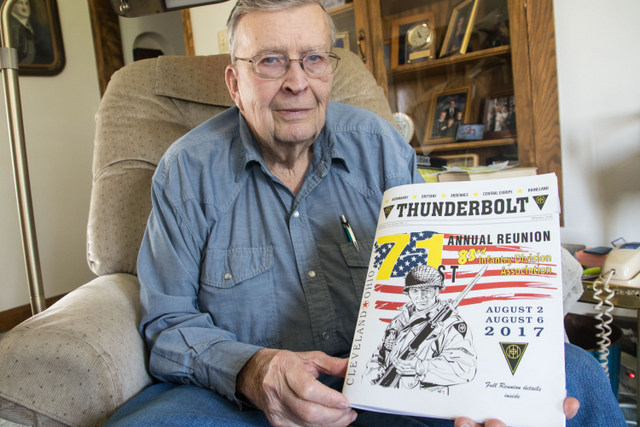
Harold Geisinger, 91, of Storm Lake, Iowa served in Europe in the U.S. Army during World War 2. This retired farmer continues to help on his family’s farm north of Storm Lake.
“Thank God it’s over”
Most of these veterans are humble, unassuming people, like Harold Geisinger of Storm Lake. I was honored to sit down with this World War 2 veteran this May. What started as as interview about his family’s Buena Vista County Century Farm turned into an unforgettable conversation about his service in the U.S. Army in the waning days of World War 2. Here’s a sample of his story, which I originally wrote for Farm News:
While V-E Day (Victory in Europe) was proclaimed “the celebration heard ‘round the world,” it was only a temporary reprieve for Harold Geisinger. This 19-year-old Iowa farm boy from Storm Lake was on his way to Le Havre, France, with the U.S. Army when Germany surrendered unconditionally to the Allies on May 7, 1945.
After a low-key celebration, Geisinger and his fellow soldiers boarded a box car in France bound for Hanover, Germany. Geisinger then joined a convoy in Bavaria, the section of Germany where American troops were guarding railroads, train depots, irrigation sites and more.
While the war was over in Europe, fighting continued on the other side of the globe. In the summer of 1945, there was talk that Geisinger and his fellow soldiers would likely be on board the next U.S. military ship bound for the Pacific Theater. Everything changed, however, when Japan surrendered on Sept. 2, 1945, following President Harry S. Truman’s orders to drop two atomic bombs on Japan in August 1945.
“When we got the word that Japan quit, we didn’t celebrate,” said Geisinger, 91, who still gets tears in his eyes when he thinks back to those days nearly 72 years ago. “We simply sat down and said, ‘Thank God it’s over.’”
Read off of Harold’s remarkable story here.
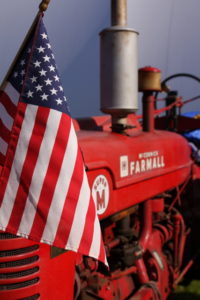 Want more?
Want more?
Thanks for stopping by and listening to these stories. I invite you to read more of my blog posts if you want more Iowa stories, history and recipes, as well as tips to make you a better communicator. If you like what you see and want to be notified when I post new stories, be sure to click on the “subscribe to blog updates/newsletter” button at the top of this page. Let’s stay in touch.
P.S. Thanks for joining me. I’m glad you’re here.
@Copyright 2017 Darcy Maulsby & Co.

Get Your Grill On: How to Build a Better Burger
Love the thrill of the grill? I sure do, especially when I’m crafting a thick, juicy burger I can sink my teeth into. While we talk a lot about burgers during May Beef Month, how much do you really know about this American icon?
The classic hamburger we know and love today is very much an American invention. Stemming from German culinary roots, the burger-on-a-bun phenomenon gained widespread fame at the 1904 St. Louis World’s Fair.
Disaster struck two years later, however, when Upton Sinclair’s novel “The Jungle” (remember the book’s lurid details from high school literature class?) detailed the unsavory side of the American meatpacking industry. Ground beef became a prime suspect, since it could easily be adulterated with questionable additives.
The hamburger might have faded away as a long-forgotten fad were it not for Edgar Ingram and Walter Anderson. When they opened their first White Castle restaurant in Kansas in 1921, White Castle countered the hamburger’s unsavory reputation by becoming bastions of cleanliness, health and hygiene. This paved the way for national hamburger chains founded in the post-World War II boom years, including McDonald’s.
Best burgers, Iowa style
Iowa has made its own distinctive contributions to America’s burger history. Consider the wildly popular Iowa’s Best Burger contest, sponsored by the Iowa Cattlemen’s Association (ICA) and the Iowa Beef Industry Council (IBIC). Iowans submitted more than 9,200 nominations for this year’s contest. Nearly 500 Iowa restaurants were represented in 2017 in the total nominations, setting a new record for the contest.
As a former judge of Iowa’s Best Burger contest, I can tell you how tough it is to pick a winner. Iowans know how to make bodacious burgers, a story I made sure to include in my “Culinary History of Iowa” book.
Size matters when it comes to the Gunderburger at the Irish Shanti, which made the 2017 Top 10 list. The famous Gunderburger started in the late 1970s to put the tiny northeast Iowa community of Gunder on the map. The first Gunderburgers were a smaller version of the one served today. As the Gunderburger started growing in size in the 1990s, its notoriety also grew.
Another 2017 Top 10 Best Burger in Iowa contender is the Ankeny Diner, which offers Maytag Burgers, featuring Iowa’s famous Maytag blue cheese, sautéed onion and Monterey jack cheese. Don’t care for blue cheese? Maybe you’d prefer the Rarebit Burger, served open-faced and topped with spicy Cheddar cheese sauce.
Rarebits were legendary at the iconic Younkers Tea Room in downtown Des Moines for decades. An Iowa-style rarebit burger elevates the traditional Welsh rarebit, which incorporates leftover bits of cheese and the end-of-the-loaf slices of stale bread for a quick supper.
Speaking of Des Moines, the historic East Village is the home of the incomparable Zombie Burger. A previous Top 10 Best Burger in Iowa contender, Zombie Burger serves “gore-met” creations made from the shop’s own custom three-cut beef burger blend. With locations in downtown Des Moines, Ankeny, West Des Moines and the Iowa City area, Zombie Burger is distinguished by classics from the Undead Elvis (a burger paired with peanut butter, fried bananas, bacon, American cheese and mayo) to the Walking Ched (a burger featuring bacon, Cheddar cheese, caramelized onions and mayo on a deep-fried macaroni-and-cheese bun).
Hungry yet?
If all this inspiration has you craving top-quality, Iowa beef, here are my top tips to make your best burgers ever:
• Choose fresh 80/20 ground beef, which provides enough fat to keep your burgers juicy and flavorful.
• Worcestershire sauce adds a whole new depth of flavor to burgers. Add in a healthy dollop and mix it into the meat before forming the patties.
• Use your thumb to create a dimple or well in the center of each patty on the bottom. This helps ensure that the burgers cook evenly. Don’t worry—the indentation will hardly be noticeable by the time the burgers are ready.
• Cook your burgers over medium heat.
• As the patties cook, sprinkle them liberally on both sides with a mixture of salt, fresh-ground pepper, Lawry’s seasoning salt, garlic powder and onion powder.
• Avoid using your spatula to press down on your burgers while cooking. Don’t let all those flavorful juices escape.
• Allow your burgers to rest for a few minutes before serving. This will ensure that the juices redistribute into the meat. Enjoy!
Have any favorite burger recipes or cooking tips? I’d love to hear them. Now go get your grill on!
Hungry for more?
Want more burger inspiration? Check out my blog post on the Lake City Drive-In, where owner Larry Irwin is not only a beef booster, but someone who sees burgers as the perfect palette for culinary creativity with his Burger of the Month flavors. (Don’t miss my recipe for Meatloaf Burgers!)
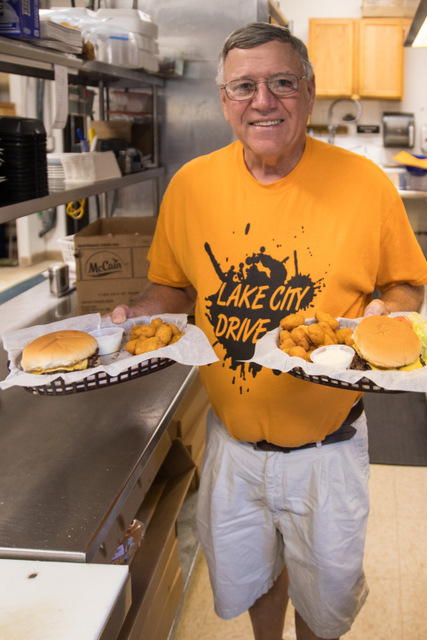
Larry Irwin shows off some tasty burgers from the Lake City Drive-In.
If you’re hungry for more stories of Iowa history, Larry is kind enough to carry my books at the Lake City Drive-In. Not close to Lake City? I invite you to visit my online store, where you can purchase my top-selling “Culinary History of Iowa: Sweet Corn, Pork Tenderloins, Maid-Rites and More” book from The History Press, as well as my “Calhoun County” book from Arcadia Publishing, which showcases the history of small-town and rural Iowa. Order your signed copies today! Iowa postcards are available in my online store, too.
One more thing–check out more of my blog posts if you want more Iowa stories, history and recipes, as well as tips to make you a better communicator. If you like what you see and want to be notified when I post new stories, be sure to click on the “subscribe to blog updates/newsletter” button at the top of this page. Let’s stay in touch!
This originally appeared as one of my weekly columns in Farm News.
P.S. Thanks for joining me. I’m glad you’re here.
@Copyright 2017 Darcy Maulsby & Co.
